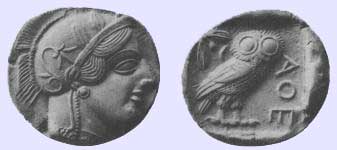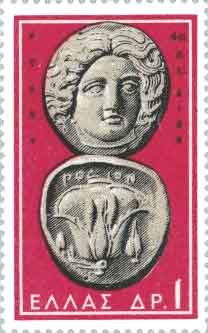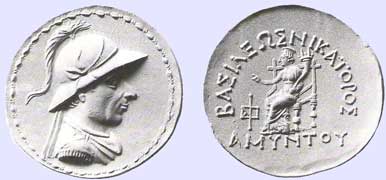.
Coins were invented in the Kingdom of Lydia, in what is now western Turkey, in about 620 BC (they were independently invented in China and India in about 600 BC). Coinaage soon spread to the independent city states of Ionia on the Aegean coast, and then to the rest of the Greek world, which extended at that time from the Black Sea to Sicily and southern Italy.
The history of Ancient Greek coins can be divided (along with most other Greek art forms), into three periods, the Archaic, the Classical and the Hellenistic. The Archaic period extends from the introduction of coinage to the Greek world in about 600 BC until the Persian Wars in about 480 BC. The Classical period then began, and lasted until the conquests of Alexander the Great in about 330 BC, which began the Hellenistic period, extending until the Roman absorption of the Greek world in the 1st century BC. The Greeks cities continued to produce their own coins for several more centuries under Roman rule, called Roman provincial coins.
Archaic period
In the "Archaic period" coins were fairly crude by later standards. They were mostly small bean-shaped lumps of gold or silver, stamped with a geometric design or symbol to indicate its city of origin. As coining techniques improved, coins became more standardised as flat disks, and the convention of putting a representation of the patron god or goddess of the issuing city became established. Animal symbols such as the owl of Athens also became popular.
The Greek world was divided into at least a thousand self-governing cities and towns (in Greek, poleis), and most of these issued their own coins. To facilitate inter-city trade, however, the coins came increasingly to be of a standard value, although marked with the symbols of the issuing city (rather like today's Euro coins, which are recognisably from a particular country, but usable all over the Euro zone). The drachm (from the Greek word for "a handful") became the most popular unit of exchange. In about 510 BC Athens began producing a fine silver tetradrachm (four drachm) coin, which was used all over the Greek world and reflected the increasing dominance of Athens.
Classical period

Tetradrachm of Athens, fifth century BC. On the obverse, a portrait of Athena, patron goddess of the city. On the reverse, the owl of Athens
The "Classical period" saw Greek coinage reach a high level of technical and aesthetic quality. Larger cities now produced a range of fine silver and gold coins, most bearing a portrait of their patron god or goddess, or a legendary hero, on one side, and a symbol of the city on the other.

Rhodes Coin, 4th century BC
Some coins employed a visual pun: coins from Rhodes featured a rose, since the Greek word for rose is rhodon. The use of inscriptions on coins also began, usually the name of the issuing city. The wealthy cities of Sicily produced some especially fine coins. The large silver decadrachm (ten drachm) coin from Syracuse is regarded by many collectors as the finest coin produced in the ancient world, perhaps ever.
The use of coins for propaganda purposes was a Greek invention. Coins are valuable, durable and pass through many hands. In an age without newspapers or other mass media, they were an ideal way of disseminating a political message. The first such coin was a commemorative decadrachm issued by Athens following the Greek victory in the Persian Wars. On these coins the owl of Athens was depicted facing the viewer with wings outstretched, holding a spray of olive leaves. The message was that Athens was powerful and victorious, but peace-loving.
Hellenistic period

Double decadrachm of the Indo-Greek ruler Amyntas (ruled 95-90 BC): the largest silver coin of Antiquity.
Obv: Helmetted bust of king.
Rev: Seated Tyche with cornucopia in left hand, and, with the right hand, making a benediction gesture identical to the Buddhist vitarka mudra. Greek legend: ΒΑΣΙΛΕΩΣ ΝΙΚΑΤΟΡΟΣ ΑΜΥΝΤΟΥ "[coin] of victorious King Amyntas".
The Hellenistic period was characterised by the spread of Greek culture across a large part of the known world. Greek-speaking kingdoms were established in Egypt and Syria, and for a time also in Iran and as far east as what is now Afghanistan. Greek traders spread Greek coins across this vast area, and the new kingdoms soon began to produce their own coins. Because these kingdoms were much larger and wealthier than the Greek city states of the classical period, their coins tended to be more mass-produced, as well as larger, and more frequently in gold. But they often lacked the aesthetic delicacy of coins of the earlier period.
Still, some of the Greco-Bactrian coins, and those of their successors in India, the Indo-Greeks, are considered the finest examples of Greek numismatic art with "a nice blend of realism and idealization", including the largest coins to be minted in the Hellenistic world: the largest gold coin was minted by Eucratides (reigned 171–-145 BC), the largest silver coin by the Indo-Greek king Amyntas (reigned c. 95-–90 BC). The portraits "show a degree of individuality never matched by the often bland depictions of their royal contemporaries further West" (Roger Ling, "Greece and the Hellenistic World").
The most striking new feature of Hellenistic coins was the use of portraits of living people, namely of the kings themselves. This practice had begun in Sicily, but was disapproved of by other Greeks as showing hubris (pride). But the kings of Ptolemaic Egypt and Seleucid Syria had no such scruples, and issued magnificent gold coins adorned with their own portraits, with the symbols of their state on the reverse. The names of the kings were frequently inscribed on the coin as well. This established a pattern for coins which has persisted ever since: a portrait of the king, usually in profile and striking a heroic pose, on the obverse, with his name beside him, and a coat of arms or other symbol of state on the reverse.
Technique
All Greek coins were hand-made, rather than milled as modern coins are. The design for the obverse was carved (in reverse) into a block of stone or iron. The design of the reverse was carved into another. The blank gold or silver disk, heated to make it soft, was then placed between these two blocks and the upper block struck hard with a hammer, "punching" the design onto both sides of the coin.
This is a fairly crude technique and produces a high failure rate, so the high technical standards achieved by the best Greek coins - perfect centering of the image on the disk, even relief all over the coin, sharpness of edges - is a remarkable testament to Greek perfectionism.
Ancient Greek coins today
The best Greek coins are rare and expensive and can only be seen in museums, of which the National Numismatic Museum in Athens is one of the finest. But large hoards of Greek coins are still being found all over Europe and the Middle East, and many of the more common coins find their way onto the market, including on Internet. Coins are the only art form from the Ancient world which are common enough and durable enough to be within the reach of ordinary collectors.

| Ancient Greece
Science, Technology , Medicine , Warfare, , Biographies , Life , Cities/Places/Maps , Arts , Literature , Philosophy ,Olympics, Mythology , History , Images Medieval Greece / Byzantine Empire Science, Technology, Arts, , Warfare , Literature, Biographies, Icons, History Modern Greece Cities, Islands, Regions, Fauna/Flora ,Biographies , History , Warfare, Science/Technology, Literature, Music , Arts , Film/Actors , Sport , Fashion --- |
Retrieved from "http://en.wikipedia.org"
All text is available under the terms of the GNU Free Documentation License

